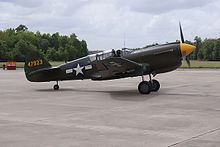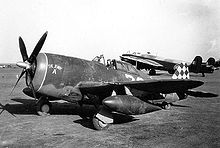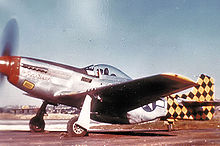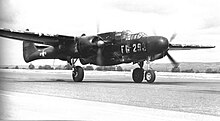325th Operations Group
| 325th Operations Group | |
|---|---|
Air Force Outstanding Unit Award | |
| Insignia | |
| 325th Operations Group emblem[note 2][2] |  |
| 325th Fighter Group emblem (World War II)[1] |  |
The 325th Operations Group is the flying component of the
The group was first activated in August 1942 as the 325th Fighter Group at
The 325th was again activated in 1947 as an all-weather fighter unit, moving late in the year to
In 1955, ADC implemented Project Arrow, which replaced its Air Defense Groups organized in the early 1950s with fighter groups that had been active during World War II. The 325th was activated once again at
The 325th remained in inactive status until 1991 when it was again activated as the 325th Operations Group.
Assigned units
The 325th Operations Group commands three flying squadrons and two support squadrons.
- 2d Fighter Training Squadron"American Beagle Squadron"
- The 2d Fighter Training Squadron was reactivated in August 2014 to operate Northrop T-38 Talons and conduct adversary training for F-22 Raptor pilots flying air superiority missions.[3]
- 43d Fighter Squadron"American Hornets" (Diagonals on tails)
- The 43d Fighter Squadron was the first squadron to receive the Lockheed Martin F-22 Raptor and is the only Raptor training squadron.[4]
- 95th Fighter Squadron "Mr. Bones"
- The 95th Fighter Squadron activated in June 2023 as an operational F-35A squadron.[5]
- 325th Training Support Squadron "Black Bears"
- The 325th Training Support Squadron manages training resources and conducts academic and simulator training for F-22 pilots, air battle managers and intelligence officers.[6]
- 325th Operations Support Squadron
- The 325th Operations Support Squadron supports F-35 pilots. The squadron controls all air traffic at Tyndall, manages the airfield complex, and provides weather observation and forecasting. The squadron also provides operations, weapons and tactics, life support and water survival training and scheduling.[7]
History
World War II



The 325th was first activated as the 325th Fighter Group at
The 325th began operations with
325th Ftr Gp Aerial Victories
| Aerial Victories | Number | Note |
|---|---|---|
| Group Hq | 19 | [13] |
| 317th Fighter Squadron | 209 | [14] |
| 318th Fighter Squadron | 173 | [15] |
| 319th Fighter Squadron | 119 | [16] |
| Group Total | 520 |
Cold War


The group was inactive from 1945 until 1947, when it was activated as an all-weather fighter group equipped with
Beginning in Spring 1949, it conducted the All Weather Combat Crew Training School, while participating in air defense operations,
In December 1951,

In 1955 the personnel and equipment of the inactivating
The group became subordinate to the 325th Fighter Wing again in October 1956 and was non-operational as all group headquarters personnel were used to man the wing headquarters until about June 1957.
Reactivation

On 1 September 1991, the group was redesignated the 325th Operations Group and activated when the 325th Fighter Wing implemented the USAF Objective Wing organization.
In October 2012, the Air Force combined both combat and training F-22 Raptor squadrons into a single group, and realigned the group under Air Combat Command.[32]
Lineage
- Constituted as the 325th Fighter Group on 24 June 1942
- Activated on 3 August 1942
- Inactivated on 28 October 1945
- Redesignated 325th Fighter Group (All Weather) on 2 May 1947
- Activated on 21 May 1947
- Redesignated: 325th Fighter Group, All Weather, on 10 May 1948
- Redesignated: 325th Fighter-All Weather Group on 20 January 1950
- Redesignated: 325th Fighter-Interceptor Group on 1 May 1951
- Inactivated on 6 February 1952
- Redesignated 325th Fighter Group (Air Defense) on 20 June 1955
- Activated on 18 August 1955
- Discontinued on 25 March 1960[note 4]
- Redesignated 325th Tactical Training Group on 31 July 1985 (remained inactive)
- Redesignated 325th Operations Group on 1 September 1991
- Activated on 1 September 1991.[33]
Assignments
|
|
Components
|
Operational Squadrons
|
Support Units
|
Stations
|
|
Aircraft
- P-40 Warhawk, 1942–1943
- P-47 Thunderbolt, 1943–1944)
- P-51D Mustang, 1944–1945, 1951–1952
- P-61 Black Widow, 1947–1948
- F-82 Twin Mustang, 1948–1951
- F-94A Starfire, 1950–1952
- F-86E Sabre, 1951
- F-86D Sabre, 1955–1957
- F-102 Delta Dagger, 1956–1960
- F-106 Delta Dart, 1960
- McDonnell Douglas F-15 Eagle, 1991–2010
- Lockheed Martin F-22 Raptor, 2003 – present[33]
Awards and campaigns
| Award streamer | Award | Dates | Notes |
|---|---|---|---|
| Distinguished Unit Citation | 30 July 1943 | Sardinia, 325th Fighter Group[11] | |
| Distinguished Unit Citation | 30 January 1944 | Italy, 325th Fighter Group[11] | |
Air Force Outstanding Unit Award |
1 July 1993–30 June 1995 | 355th Operations Group[2] | |
| Air Force Outstanding Unit Award | 1 July 1995–30 June 1996 | 355th Operations Group[2] | |
| Air Force Outstanding Unit Award | 1 July 1996–30 June 1997 | 355th Operations Group[2] | |
| Air Force Outstanding Unit Award | 1 July 1997–30 June 1999 | 355th Operations Group[2] | |
| Air Force Outstanding Unit Award | 1 July 1999–30 June 2001 | 355th Operations Group[2] | |
| Air Force Outstanding Unit Award | 1 July 2001–30 June 2002 | 355th Operations Group[2] | |
| Air Force Outstanding Unit Award | 1 July 2002–30 June 2004 | 355th Operations Group[2] | |
| Air Force Outstanding Unit Award | 1 July 2004–30 June 2005 | 355th Operations Group[2] | |
| Air Force Outstanding Unit Award | 1 July 2005–30 June 2006 | 355th Operations Group[2] | |
| Air Force Outstanding Unit Award | 1 July 2006–30 June 2007 | 355th Operations Group[2] | |
| Air Force Outstanding Unit Award | 1 July 2008–30 June 2009 | 355th Operations Group[2] |
| Campaign Streamer | Campaign | Dates | Notes |
|---|---|---|---|
| American Theater without inscription | 3 August 1942 – 7 February 1946 | 325th Fighter Group | |
| Tunisia | 28 February 1943 – 13 May 1943 | 325th Fighter Group[11] | |
| Sicily | 14 May 1943 – 17 August 1943 | 325th Fighter Group[11] | |
| Naples-Foggia | 18 August 1943 – 21 January 1944 | 325th Fighter Group[11] | |
| Rome-Arno | 22 January 1944 – 9 September 1944 | 325th Fighter Group[11] | |
| Southern France | 15 August 1944 – 14 September 1944 | 325th Fighter Group[11] | |
| North Apennines | 10 September 1944 – 4 April 1945 | 325th Fighter Group[11] | |
| Central Europe | 22 March 1944 – 21 May 1945 | 325th Fighter Group[11] | |
| Po Valley | 3 April 1945 – 8 May 1945 | 325th Fighter Group[11] | |
| Air Combat, EAME Theater | 28 February 1943 – 11 May 1945 | 325th Fighter Group[11] | |
| Normandy | 6 June 1944 – 24 July 1944 | 325th Fighter Group[11] | |
| Northern France | 25 July 1944 – 14 September 1944 | 325th Fighter Group[11] | |
| Rhineland | 15 September 1944 – 21 March 1945 | 325th Fighter Group[11] | |
| Air Offensive, Europe | 28 February 1943 – 5 June 1944 | 325th Fighter Group[11] |
See also
- List of F-86 Sabre units
- F-94 Starfire units of the United States Air Force
- List of F-106 Delta Dart units of the United States Air Force
- List of F-15 operators
References
Notes
- Explanatory notes
- ^ Aircraft in foreground is Lockheed Martin F/A-22A LRIP Lot 2 Block 10 Raptor 02-2029.
- ^ Approved 1 October 1951.
- ^ Aircraft is P-61B-20-NO Black Widow serial 43-8293 at Hamilton Field
- ^ The group is not related to a 325th Fighter Group (Air Defense), Provisional that was organized at McChord on 1 November 1960 and discontinued on 1 February 1961. see Cornett & Johnson, p. 78.
- Citations
- ^ a b c Watkins, p. 40
- ^ a b c d e f g h i j k l m n o p q r s t u Kane, Robert B. (14 January 2011). "Factsheet 325 Operations Group (AETC)". Air Force Historical Research Agency. Retrieved 23 May 2012.
- ^ Olwell, Chris (21 August 2014). "'Beagles' to be reactivated". Panama City News Herald. Retrieved 30 April 2015.
- ^ "Factsheet 43rd Fighter Squadron". Tyndall AFB Public Affairs. 17 December 2013. Archived from the original on 9 June 2011. Retrieved 29 April 2015.
- ^ Roza, David. "Historic 'Boneheads' Squadron Reactivated at Tyndall, With F-35s Coming in August". Air & Space Forces Magazine. Retrieved 21 June 2023.
- ^ "Factsheet 325th Training Support Squadron". Tyndall AFB Public Affairs. 4 December 2014. Retrieved 29 April 2015.
- ^ a b "Factsheet 325th Operations Support Squadron". Tyndall AFB Public Affairs. 26 July 2013. Retrieved 29 April 2015.
- ^ a b c d Maurer, pp. 386–387
- ^ a b c Maurer, Combat Squadrons, pp. 388-389
- ^ Maurer, Combat Squadrons, pp. 390-391
- ^ a b c d e f g h i j k l m n o p q r s t u v w x y z aa ab Maurer, Combat Units, pp. 206–208
- ^ Abstract, History of 325th Fighter Group, June 1944]. Retrieved 24 May 2012 "Abstract, History 325 Fighter Group Jun 19144". Air Force History Index. Retrieved 24 May 2012.
- ^ Newton & Senning, p. 599
- ^ Newton & Senning, pp. 594-596
- ^ Newton & Senning, pp. 597-598
- ^ Newton & Senning, pp. 598-599
- ^ "Abstract, History 325 Fighter Group(AW) Jul-Dec 1948". Air Force History Index. Retrieved 24 May 2012.
- ^ Ravenstein, p. 10
- ^ a b Cornett & Johnson, p. 122
- ^ a b c d Cornett & Johnson, p. 125
- ^ Endicott, p. 65
- ^ Grant, p. 33
- ^ Cornett & Johnson, p. 66
- ^ Cornett & Johnson, p. 85
- ^ a b Buss, et al., p.6
- ^ Maurer, Combat Squadrons, pp. 571-572
- ^ a b c d e Cornett & Johnson, p. 138
- ^ a b Cornett & Johnson, p. 151
- ^ a b Abstract, History of 325th USAF Hospital, Jul-Dec 1955 Archived 13 December 2013 at the Wayback Machine. Retrieved 23 May 2012
- ^ a b Maurer, Combat Squadrons, p. 244
- ^ a b Elsea, SSG Rachelle (5 September 2012). "325th ACS to remain under AETC". 325th Fighter Wing Public Affairs. Retrieved 3 July 2015.
- ^ Elsea, SSG Rachelle (4 October 2012). "325th FW reassigned to ACC in ceremony". 325th Fighter Wing Public Affairs. Retrieved 1 May 2015.
- ^ a b c d Lineage, including assignments, components, stations and aircraft in Kane, AFHRA Factsheet 325 Operations Group, except as noted.
- ^ "Factsheet 1 Fighter Squadron". Air Force Historical Research Agency. 2 January 2008. Retrieved 23 May 2012.
- ^ "Factsheet, 1st Fighter Squadron (Inactivated December 15, 2006)". 325th Fighter Wing Public Affairs. 18 December 2006. Retrieved 1 July 2015.
- ^ Bailey, Carl E. (17 March 2015). "Factsheet 2 Fighter Squadron". Air Force Historical Research Agency. Archived from the original on 7 August 2016. Retrieved 28 April 2015.
- ^ Bailey, Carl E. (16 March 2015). "Factsheet 43 Fighter Squadron (AETC)". Air Force Historical Research Agency. Archived from the original on 4 March 2016. Retrieved 28 April 2015.
- ^ Robertson, Patsy (30 January 2009). "Factsheet 64 Aggressor Squadron (ACC)". Air Force Historical Research Agency. Retrieved 23 May 2012.
- ^ Robertson, Patsy (20 February 2015). "Factsheet 95 Fighter Squadron". Air Force Historical Research Agency. Archived from the original on 4 March 2016. Retrieved 28 April 2015.
- ^ Maurer, Combat Squadrons, pp. 390-391. The online copy includes a handwritten notation of the attachment of the squadron.
- ^ a b c d e See Mueller, p. 395 for a list of support units activated in August 1955 along with the group.
- ^ Warnock, A. Timothy (7 July 2009). "Factsheet 325 Air Control Squadron (AETC)". Air Force Historical Research Agency. Retrieved 25 May 2012.
- ^ Cornett & Johnson, p. 142
Bibliography
![]() This article incorporates public domain material from the Air Force Historical Research Agency
This article incorporates public domain material from the Air Force Historical Research Agency
- Buss, Lydus H.(ed), Sturm, Thomas A., Volan, Denys, and McMullen, Richard F., History of Continental Air Defense Command and Air Defense Command July to December 1955, Directorate of Historical Services, Air Defense Command, Ent AFB, CO, (1956)
- Cornett, Lloyd H; Johnson, Mildred W (1980). A Handbook of Aerospace Defense Organization, 1946–1980 (PDF). Peterson AFB, CO: Office of History, Aerospace Defense Center. Archived from the original (PDF) on 13 February 2016. Retrieved 24 May 2012.
- Endicott, Judy G., ed. (2001). The USAF in Korea, Campaigns, Units and Stations 1950-1953 (PDF). Maxwell AFB, AL: Air Force Historical Research Agency. ISBN 0-16-050901-7.
- Grant, C.L., (1961) The Development of Continental Air Defense to 1 September 1954, USAF Historical Study No. 126
- Maurer, Maurer, ed. (1983) [1961]. Air Force Combat Units of World War II (PDF) (reprint ed.). Washington, DC: Office of Air Force History. LCCN 61060979.
- Maurer, Maurer, ed. (1982) [1969]. Combat Squadrons of the Air Force, World War II (PDF) (reprint ed.). Washington, DC: Office of Air Force History. OCLC 72556.
- Mueller, Robert (1989). Air Force Bases, Vol. I, Active Air Force Bases Within the United States of America on 17 September 1982 (PDF). Washington, DC: Office of Air Force History. ISBN 0-912799-53-6.
- Newton, Wesley P. Jr. and Senning, Calvin F., (1963) USAF Credits for the Destruction of Enemy Aircraft, World War II, USAF Historical Study No. 85
- Ravenstein, Charles A. (1984). Air Force Combat Wings, Lineage & Honors Histories 1947-1977. Washington, DC: Office of Air Force History. ISBN 0-912799-12-9.
- Watkins, Robert A. (2009). Insignia and Aircraft Markings of the U.S. Army Air Force In World War II. Vol. IV, European-African-Middle Eastern Theater of Operations. Atglen,PA: Shiffer Publishing, Ltd. ISBN 978-0-7643-3401-6.
- Further reading
- Green, Hershel H. (2000). Herky! The Memoirs of a Checkertail Ace. Atglen, PA: Schiffer Publishing, Ltd. ISBN 0-7643-0073-3.
- McDowell, Ernest R. (1994). Checkertails: The 325th Fighter Group in the Second World War. Carrollton, TX: Squadron/Signal Publications, Inc. ISBN 0-89747-316-7.
- McDowell, Ernest R.; Hess, William N. (1969). Checkertail Clan: The 325th Fighter Group in North Africa and Italy. Fallbrook, CA: Aero Publishers, Inc. ISBN 978-0-81689-750-6.
- Rogers, Brian. (2005). United States Air Force Unit Designations Since 1978. Hinkley, UK: Midland Publications. ISBN 1-85780-197-0.
External links
![]() Media related to 325th Fighter Group (United States Army Air Forces) at Wikimedia Commons
Media related to 325th Fighter Group (United States Army Air Forces) at Wikimedia Commons



